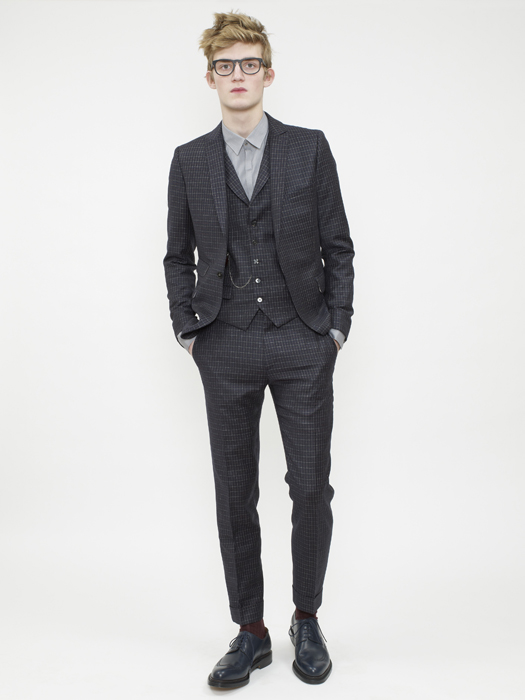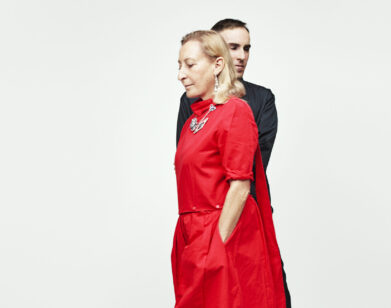The New Man and the New Menswear at Lacroix

EXCLUSIVE PHOTOS COURTESY OF CHRISTIAN LACROIX
Once synonymous with baroque, poofy, and extraordinaire, recession-hit Christian Lacroix had no choice but to shut down his fashion house last year. This men’s fashion week, the brand is relaunching sans Christian, in a humble, hush-hush manner, through a showroom held at the Maria Luisa boutique by Paris’ Tuileries. The company’s new creative director, Sasha Wolkoff, who previously worked as Lacroix’s assistant for 17 years, is now in charge, and has a brand-new vision for the maison. Wolkoff met up with Interview days before the presentation and discussed the meaning of luxury today.
ALICE PFEIFFER: So what has been going at Lacroix since 2009?
SASHA WOLKOFF: We’ve been working on a new strategy. As you know, in 2009, we closed. Later that year the Tribunal de Paris (the city’s court) decided that we could go on running the company, but in a less expensive manner. Christian left because to him, Lacroix without couture was not Lacroix. But I have been there for 18 years, and I was dedicated to proving that it can be a success, with a few adjustments.
PFEIFFER: And today? Are you properly re-opening?
WOLKOFF: Yes, but carefully so. We are focusing on developing licenses, and are currently launching lines of stationery, leather goods, fabrics, accessories, glasses, and watches. We are relaunching the Lacroix homme line this men’s week, which was initially created 4 years ago and found great success then. We didn’t want a show but something more simple, more intimate.
PFEIFFER: What are we going to see at the presentation? Who is the Lacroix homme today?
WOLKOFF: The collection is called “migratory boys,” and I am the first customer. The starting point was my need for practical, elegant, French clothes when traveling the world. So the collection is for boys on the go, ’round the globe. We encourage our male customers to mix and match, accessorize with ethnic elements, bits and pieces found in flea markets—this is about being a Parisian dandy.
PFEIFFER: How about women? Will you be relaunching during the next ready-to-wear week?
WOLKOFF: No, we won’t relaunch right away. We eventually will, but not right now because this is quite a risky move: either people will think it’s very Lacroix, which they already know, or say this is not Lacroix anymore. So we want to first redefine our universe via accessories, offering more affordable goods, while keeping some luxury pieces too.
PFEIFFER: You have been at Christian’s side for 17 years; how was it working with him?
WOLKOFF: We had a wonderful relationship, and he’s someone I have a great respect for, but also love as a human being. His unique quality was the fact that everyone in the company could have their say, and he’d always listen and respect their views. But unfortunately, he was focused on the couture aspect, which in times of recession is simply not realistic anymore.
PFEIFFER: And today, are you still in touch with him?
WOLKOFF: To tell you the truth, I haven’t heard from him since he left. It’s a tough situation not to be able to use your name, but I think he is actually doing what he really loves: these days, he has been designing costumes for the opera and getting involved in contemporary art events. We also just found out that he’ll be doing a line for Desigual, which is a very positive thing and should help to exorcise the past. I am very fond of Monsieur Lacroix, but he did have a dark side. There was the Lacroix people knew and the other Lacroix—as with most famous people.
PFEIFFER: Is it frustrating to be working mostly on licenses?
WOLKOFF: No, I’m just trying to catch the attention of a younger audience, and to create a product adapted to daily life. We worked for years on the extraordinary and the marvelous, but today, I’m aiming for a more practical, realistic—but passionate—approach to the house. Luxury is before anything a state of mind, and you can create a similar impact whether something is 60 or 10,000 Euros.
PFEIFFER: Can Lacroix still be relevant, even to young fashion followers?
WOLKOFF: Surprisingly, we have a lot in common with younger generations and bloggers. Today teenagers and very young adults look for alternatives in fashion, like we did in the ’80s: what is available is not interesting, and high end is out of the question, so we hunt around for other options and compose an eclectic look. And this is what the house was about, initially: mixing expensive, secondhand, and affordable.
PFEIFFER: And after all these years of work for someone else, wouldn’t you rather start your own company?
WOLKOFF: As I said, it’s now my 18th year at Lacroix and I believe in it, like some of the staff members who have been here for decades. I had a chance to work with Christian himself, and today to be able to offer a new model. This is Lacroix, Chapter Two.






